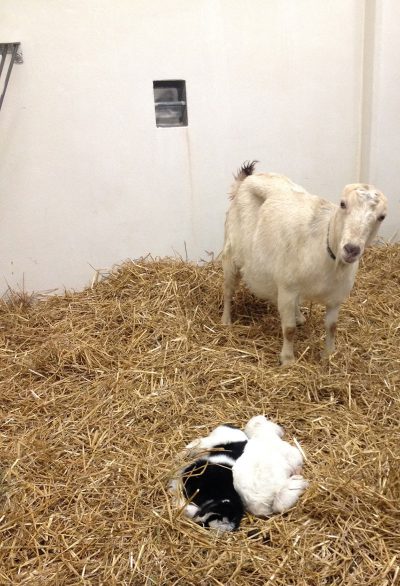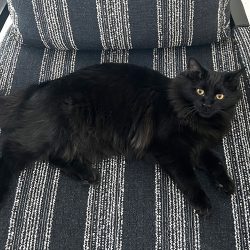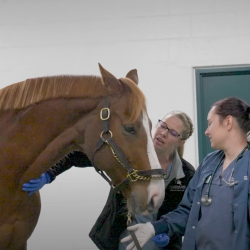
History and Diagnosis
A six-year-old LaManacha doe named Sky was presented to the Large Animal Clinic at the MSU Veterinary Medical Center late one afternoon for a dystocia, meaning she was unable to give birth. Sky had gone into labor at around lunch time. The owner attempted to help the doe deliver. She was birthing two kids at once, and despite attempts to reposition the kids, no progress was made. The owner loaded the doe into her pickup truck and brought the doe to the Hospital for assistance.
Treatment and Outcome
A vaginal exam at the Large Animal Clinic revealed that the kids were still in the same position and not likely to be delivered vaginally without potential trauma to the doe. The owner wanted Sky to have the best chance of survival and agreed to have a C-section performed. The doe was prepared for surgery and placed in lateral recumbancy under injectable anesthesia to keep her quieter during surgery since the kids were likely dead.A flank incision was made and the uterus was exteriorized. Two kids were removed. To everyone’s surprise, the buck and doe kids were alive, but very stressed and depressed. The uterus and abdominal incisions were routinely closed. Sky was given Cetifour and Banamine postoperatively and was continued on Cetifour for several days.
The kids required resuscitation including suction, oxygen, and drugs to reverse the injectable anesthetic given to the doe. The buck kid showed signs of recovery soon after resuscitation, but the doe kid had a difficult time and required suction multiple times while still in surgery. As soon as the kids were reasonably stable, colostrum that had been collected from the doe before surgery was given to the kids via a stomach tube.
The doe and the kids were placed in a stall and closely monitored. Sky recovered well. So did Earl, the buck kid. However, Pearl, the doe kid, required additional suction over the next several hours before she could breathe adequately on her own. The kids were tube fed every six hours until discharge the next day since they still did not have a suckle reflex.At discharge, the buck kid was able to stand and move around the stall. The doe kid was only able to sit sternal.
At home, the owner placed the kids in a box in the house and continued to tube feed them. By that evening, the Earl was nursing a bottle well and was returned to the barn and to his very happy mother. Pearl needed to be tube fed for several days before she could nurse a bottle. To reduce the stress that feeding two kids would place on the doe, the doe kid would be raised on a bottle.
Comments
The doe and her kids made an uneventful recovery after discharge from the Hospital. This case demonstrates the urgency needed in dealing with a dystocia. If the fetus cannot be delivered normally, a C-section will be needed. Waiting will not improve the chances of a successful outcome. When a C-section is performed and the fetus(es) are still alive or have just recently died, the doe normally survives without complications. Conversely, a doe in prolonged labor with dead fetus(es) and a compromised uterus will have a difficult recovery. Subsequent breeding is normally not affected by a C-section.
Having the ability to tube feed a neonate is essential when a suckle reflex is absent or weak. Tube feeding a ruminant is a skill easily taught to a client by their veterinarian. Both these kids required multiple tube feedings before they could suckle appropriately. If not tube fed, the kids would have either starved to death, aspirated milk, or developed aspiration pneumonia.
The Large Animal Clinic at the MSU Veterinary Medical Center is a full service hospital that provides both daily and emergency care 365 days a year. We only ask that you call ahead so we are ready and able to provide the best possible care for your animal.



